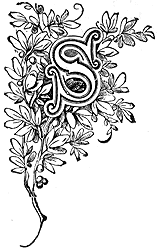 |

OUTHWARD of the Castle lies the great park, a portion of Windsor Forest,
which the reign of Queen Anne was cut off from the Castle by intervening
property. It was therefore determined to buy enough land to complete an avenue
from the Castle to the Forest; this was done, and it became the Long Walk,
generally considered the finest avenue in Europe. It is a perfectly straight
line for three miles, running from the principal entrance to the Castle to the
top of a hill, called Snow Hill. On each side of this magnificent walk is a
double row of stately elms; on Snow Hill is placed a colossal statue of George
III.
Windsor Great Park is indeed one of the stateliest woods that we can find in
England. There is in it "a prodigality of shade" formed by some of the most
beautiful beech trees in the country. The venerable pollards also are most
interesting, for beneath their shade have walked many of our kings and famous
men; Shakespeare perhaps, and certainly Pope.
The size of some of these old trees is amazing. One beech tree near Sawyer's
Lodge measured at six feet from the ground, thirty-six feet round. There are
two magnificent old oaks near Cranbourne Lodge, one, at six feet from the
ground, measures thirty-eight feet round; the other tree is thirty-six feet in
circumference at four from the ground.
The most interesting tree, however, in Windsor Park is Herne's oak.
"In following the footpath which leads from the Windsor road to
Queen Adelaide's Lodge in the Little Park, about half-way on the right a dead
tree may be seen, close to an avenue of elms. This is what is pointed out as
Herne's oak. It looks the picture of death itself. Not a leaf, not a particle
of vitality appears about it. It stretches out its bare and sapless branches,
like the skeleton arms of some enormous giant, and is almost fearful in its
decay.
Its spectral branches might indeed deter many from coming near it 'twixt twelve and one."
"I was glad," continues Mr. Jesse, from whose "Gleanings" the above is taken,
- "I was glad to find a pit hard by, whence Nan and her troop of fairies and
the Welch devil, Evans, might all have crouched without being perceived by the
'fat Windsor stag,' when he spake like Herne the Hunter." The pit above
alluded to has recently had a few thorns planted in it, and the circumstance
of its being near the oak, with the diversion of the footpath, seems to prove
the identity of the tree, in addition to the traditions respecting it,-
The last acorn from Herne's oak was planted by Sir David Dundas, in
his estate in Wales, where the tree still flourishes that grew from it.
In September the fern, then become golden, is extremely beautiful.
Virginia Water is another lovely spot when seen glittering in the sunshine,
with the fishing boats and the pretty frigate on it; it is a delightful
contrast to the woody scenery. The Belvedere and the Obelisk are, also,
happily placed. Before George IV. bestowed them on the Zoological Gardens,
wild animals were kept in this park; and Mr. Jesse tells us a rather
sensational story of the person who was their keeper. He took pleasure in
petting the boa constrictor, and was accustomed to allow it a certain degree
of liberty, by letting it loose in his own sitting-room. One day his pet
(playfully, perhaps) wound himself round his friend's body, and would probably
have crushed him to death, had not his cries brought help, and the animal been
disengaged from him. Happily the snake had not been able to fix its tail to
anything, or probably it would have succeeded in crushing its beloved victim
at once. Happily there are no longer snakes or wild beasts at royal Windsor.
The great public school of Eton, founded by Henry VI., is close to the royal
founder's palace, and is a lasting memorial of his goodness and sense of the
necessity of education. Henry of Windsor was, when sane, one of our most
saintly kings; unhappily he inherited insanity from his maternal grandfather,
Charles VI. of France.
Eton has sent forth many distinguished men. The Duke of Wellington used to
say that Waterloo was won at Eton, alluding to its athletic sports and games;
and one cannot read Kinglake's description of the Balaclava charge without
perceiving the full truth of the Duke's remark. It was an Eton boy who planted
the English flag on the heights of Alma, and fell - the heroic lad - in the act.
Eton seems peculiarly connected with Windsor, and the loyalty of the boys is
notorious. The Queen has nowhere more devoted subjects than at Eton.
|
 |